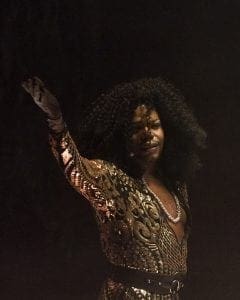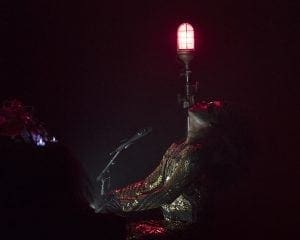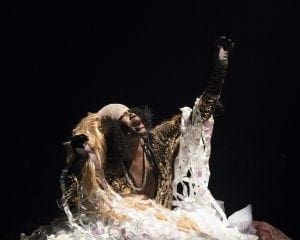A Séancers Syllabus
This weekend, Nigerian–American curator, poet, and performance artist Jaamil Olawale Kosoko brings his latest work to FringeArts. Informed by the deaths of all his immediate family members, Séancers collapses lyrical poetry, movement forms, and discursive performance to explore how the American racialized body uses psychic, spiritual, and theoretical strategies to shape shift through loss and oppression.
Kosoko’s artistic practice is in many ways guided by his voracity as a reader and, in the case of Séancers, many of the works that inspired the piece were also pertinent to his grieving process, to seeing his loss in a greater context of cultural erasure and systemic oppression of Black people in America. At the top of a recent episode of Terrible, Thanks for Asking, he offered, “I think of a quote by James Baldwin: ‘You think your pain and your heartbreak are unprecedented in the history of the world, but then you read.’ And I think really situating myself inside of being bookish has allowed me an understanding to know that my story is not particularly unique.”
Below is a list of texts and works that inspired Kosoko to make Séancers—a mix of Black theory, poetry, performance art, and video art—along with links and quotes (some direct, some contextual) to help spark your own exploration into these illuminating sources.
Mumia Abu-Jamal and Cornel West, “The Empire Files: Black Radical Tradition”
James Baldwin, The Price of the Ticket (Viewing and Reading)
“If Raoul Peck’s fiery documentary I Am Not Your Negro piqued your interest in all things James Baldwin, then try this movie as a companion piece… This 1989 documentary is full of archival footage, recordings of Baldwin reading his work, old interviews, photographs and memories from friends like Maya Angelou and Amiri Baraka. Although some scenes, like a recreation of Baldwin’s fight with his father, haven’t aged gracefully, the documentary’s focus on Baldwin’s personal and creative life humanizes this literary legend.” — Monica Castillo, The New York Times
Tina Campt, “Black Feminist Futures and The Practice of Fugitivity”
James H. Cone, The Cross and Lynching Tree
“The lynching tree is the most potent symbol of the trouble nobody knows that blacks have seen but do not talk about because the pain of remembering… is almost too excruciating to recall. In that era, the lynching tree joined the cross as the most emotionally charged symbols in the African American community—symbols that represented both death and the promise of redemption, judgement and the offer of mercy, suffering and the power of hope. Both the cross and the lynching tree represented the worst in human beings and at the same time ‘an unquenchable ontological thirst’ for life that refuses to let the worst determine our final meaning.” — James H. Cone
Thomas DeFrantz, “i am black (you have to be willing to not know)“
“The discourse of race in contemporary performance falls apart when whites try to understand black performance. Contemporary black performance is saturated with experience and complexities that evade easy affiliations or knowings. This dialogic manifesto-lecture-performance offers strategies for acknowledging how artists of color and their collaborating audiences of color operate in several keys simultaneously but are inevitably compelled to reduce their work and experience to the unknowable, shameful category of ‘race.'” — Thomas DeFrantz
Brenda Dixon Gottschild, Black Dancing Body: A Geography from Coon to Cool
“With dance as the focus and race the parameter, this work is a personalized cultural study, the third installment in my exploration/excavation of Africanist presences in performance. When Michael Flamini approached me about writing a history of ‘black’ dance, I responded that, instead, I wanted to tell the story as a geography of the body itself… I interrogate the black dancing body through personal experience, critical analysis of visual and print documentation, and through the eyes of the 24 contemporary dance practitioners interviewed for this book.” — Brenda Dixon Gottschild, taken from the introduction
Danielle Goldman, I Want To Be Ready: Improvised Dance as a Practice of Freedom
“‘Freedom’ is a persistent fixture in discussions of improvisation and the arts—and yet its precise meaning is rarely examined. In fact, in most cases it seems to function as little more than shorthand, pointing toward something good with vaguely political implications… I Want to Be Ready [goes] against the grain of most written accounts of improvised dance to suggest that improvisation does not reflect or exemplify the understanding of freedom as a desired endpoint devoid of constraint. On the contrary, it actively resists it.” — Danielle Goldman, taken from the introduction
Stuart Hall, “Cultural Identity and Diaspora“
“Identity is not as transparent or unproblematic as we think. Perhaps instead of thinking of identity as an already accomplished fact, which the new cultural practices then represent, we should think, instead, of identity as a ‘production’, which is never complete, always in process, and always constituted within, not outside, representation. This view problematises the very authority and authenticity to which the term, ‘cultural identity’, lays claim.” — Stuart Hall
bell hooks, Teaching to Transgress: Education as a Practice of Freedom
“There is a serious crisis in education. Students often do not want to learn and teachers do not want to teach. More than ever before in the recent history of this nation, educators are compelled to confront the biases that have shaped teaching practices in our society and to create new ways of knowing, different strategies for the sharing of knowledge. We cannot address this crisis if progressive critical thinkers and social critics act as though teaching is not a subject worthy of our regard.” — bell hooks, taken from the introduction
Fred Moten, In the Break (“Resistance of The Object”)
“What if the beholder glances, glances away, driven by aversion as much as desire? This is to ask not only, what if beholding were glancing; it is also—or maybe even rather—to ask, what if glancing is the aversion of the gaze, a physical act of repression, the active forgetting of an object whose resistance is now not the avoidance but the extortion of the gaze?” — Fred Moten
Fred Moten, The Undercommons (“The Wild Beyond”)
“If you want to know what the undercommons wants, what Moten and Harney want, what black people, indigenous peoples, queers and poor people want, what we (the ‘we’ who cohabit in the space of the undercommons) want, it is this – we cannot be satisfied with the recognition and acknowledgement generated by the very system that denies a) that anything was ever broken and b) that we deserved to be the broken part; so we refuse to ask for recognition and instead we want to take apart, dismantle, tear down the structure that, right now, limits our ability to find each other, to see beyond it and to access the places that we know lie outside its walls.” — Jack Halberstam
José Esteban Muñoz, Disidentifications (“Performing Disidentifications”)
“The story of identity formation predicated on ‘hybrid transformations’ that this text is interested in telling concerns subjects whose identities are formed in response to the cultural logics of heteronormativity, white supremacy, and misogyny—cultural logics that I will suggest work to undergird state power. The disidentificatory performances that are documented and discussed here circulate in subcultural circuits and strive to envision and activate new social relations.” — José Esteban Muñoz, taken from the introduction
Soraya Murray & Derek Murray, “Public Ritual: William Pope.L and exorcisms of abject otherness“
“At 62, Pope.L is inarguably the greatest performance artist of our time. This is exactly the kind of label he would find absurd, but over the course of the last four decades, no artist has so consistently broken down the accepted boundaries of the genre in order to bring it closer to the public, with lacerating, perspicacious and gloriously anti-authoritarian projects that play with our received notions of race and class and almost always cut more than one way.” — Megan O’Grady, from a recent New York Times profile of Pope.L
Okwui Okpokwasili, Bronx Gothic
“In 2014, I saw Okpokwasili in her piece Bronx Gothic, and the top of my head blew off… The piece is a tour de force on the order of Toni Morrison’s The Bluest Eye, the author’s seminal text on black girlhood and power.” — Hilton Als, The New Yorker
Editor’s note: FringeArts presented Bronx Gothic in 2016. It has since become the subject of a documentary by director Andrew Rossi. Watch the trailer here. You can also check out a reading list for that show provided to us by Okpokwasili here.
Howardena Pindell, Free White and 21
Claudia Rankine, Citizen: An American Lyric
“One of the things I wanted the book to do was speak to intimate moments. I asked a lot of friends and people I’d meet, ‘Can you tell me a story of a micro-aggression that happened to you in a place you didn’t expect it to happen?’ I wasn’t interested in scandal, or outrageous moments. I was interested in the surprise of the intimate, or the surprise of the ordinary. So you’re just moving along and suddenly you get this moment that breaks your ability to continue, and yet you continue.” — Claudia Rankine in an interview with Guernica
Ruby Sales, in conversation with Michelle Alexander
Christina Sharpe, In the Wake: On Blackness and Being
“What does it mean to defend the dead? To tend to the Black dead and dying: to tend to the Black person, to Black people, always living in the push toward our death? It means work. It is work: hard emotional, physical, and intellectual work that demands vigilant attendance to the needs of the dying, to ease their way, and also to the needs of the living.” — Christina Sharpe
Hortense Spillers, “Mama’s Baby, Papa’s Maybe: American Grammar Notebook“
“It seems clear, however, that ‘Family,’ as we practice and understand it ‘in the West’ – the vertical transfer of a bloodline, of a patronymic, of titles and entitlements, of real estate and the prerogatives of ‘cold cash,’ from fathers to sons and in the supposedly free exchange of affectional ties between a male and a female of his choice – becomes the mythically revered privilege of a free and freed community. In that sense, African peoples in the historic Diaspora had nothing to prove, if the point had been that they were not capable of ‘family’ (read ‘civilization’), since it is stunningly evident, in Equiano’s narrative, for instance, that Africans were not only capable of the concept and the practice of ‘family,’ including ‘slaves,’ but in modes of elaboration and naming that were at least as complex as those of the ‘nuclear family’ ‘in the West.'” — Hortense Spillers
Séancers
Jaamil Kosoko Performance
May 10-12
FringeArts
140 N. Columbus Boulevard
$29 general
$20.30 members
$15 student/25-and-under
Intro by Hugh Wilikofsky.






